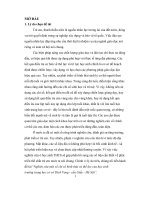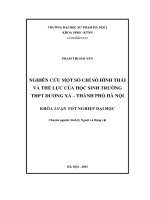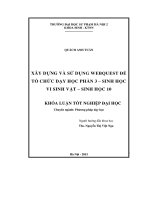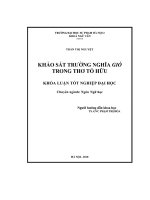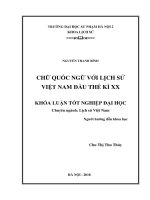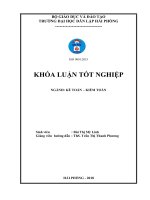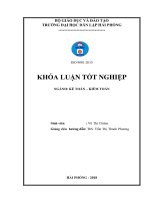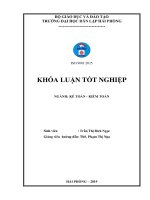Khóa luận tốt nghiệp using some techniques for english vocabulary learning to improve the grade 6th students vocabulary at vinh lac primary and secondary school
Bạn đang xem bản rút gọn của tài liệu. Xem và tải ngay bản đầy đủ của tài liệu tại đây (1.14 MB, 83 trang )
VIETNAM NATIONAL UNIVERSITY OF AGRICULTURE
FACULTY OF EDUCATION AND FOREIGN LANGUAGES
BA THESIS
USING SOME TECHNIQUES FOR ENGLISH
VOCABULARY LEARNING TO IMPROVE THE GRADE
6TH STUDENTS’ VOCABULARY AT VINH LAC
PRIMARY AND SECONDARY SCHOOL
SỬ DỤNG MỘT SỐ KỸ THUẬT TRONG VIỆC HỌC TỪ
VỰNG TIẾNG ANH ĐỂ CẢI THIỆN VỐN TỪ VỰNG CHO
HỌC SINH KHỐI 6 TRƯỜNG TH&THCS VĨNH LẠC
Student: HOANG THI THU HUYEN
Student code: 621207
Major: ENGLISH
Supervisor: BUI THI LA, M.A
HANOI – 2021
i
CERTIFICATE OF ORIGINALITY
I, the undersigned, hereby certify my authority of the study project report
entitled “Using some techniques for English vocabulary learning to improve the
grade 6th students’ vocabulary at Vinh Lac Primary and Secondary School”
submitted in partial fulfillment of the requirements for the degree of Bachelor in
English Language. Except where the reference is indicated, no other person’s
work has been used without due acknowledgement in the text of the thesis.
Hanoi, 2021
Hoang Thi Thu Huyen
Approved by
SUPERVISOR
(Signature and full name)
Date:……………………
i
TABLE OF CONTENTS
CERTIFICATE OF ORIGINALITY ..................................................................... i
TABLE OF CONTENTS ...................................................................................... ii
ABSTRACT ......................................................................................................... iv
ACKNOWLEDGEMENT .................................................................................... v
PART 1: INTRODUCTION ................................................................................. 1
1.1. Rationale for the study ................................................................................... 1
1.2. Aims and Objectives ...................................................................................... 2
1.3. Research question. .......................................................................................... 3
1.4. Scope of the study. ......................................................................................... 3
1.5. Significance of the study. ............................................................................... 4
1.6. Design of the study ......................................................................................... 4
PART 2: DEVELOPMENT .................................................................................. 6
CHAPTER 1: LITERATURE REVIEW .............................................................. 6
1.1. REVIEW OF PREVIOUS STUDIES (AT HOME AND ABROAD) .......... 6
1.1.1. Study at home .............................................................................................. 6
1.1.2. Study abroad ................................................................................................ 7
1.2. REVIEW OF THEORETICAL BACKGROUND ........................................ 9
1.2.1. The definition of vocabulary ....................................................................... 9
1.2.2. Types of vocabulary .................................................................................. 10
1.2.3. The importance of vocabulary .................................................................. 11
1.2.4. The importance of learning vocabulary .................................................... 13
1.2.5. The most common vocabulary teaching in English context. .................... 14
1.2.6. Vocabulary teaching and learning techniques. ......................................... 17
1.3. SUMMARY ................................................................................................. 23
CHAPTER 2: METHODOLOGY ...................................................................... 24
2.1. ACTION RESEARCH ................................................................................. 24
2.1.1. Definition................................................................................................... 24
2.1.2. Reasons for the use of Action research. .................................................... 27
2.2. RESEARCH SETTING ............................................................................... 27
2.3. RESEARCH PROCEDURES ...................................................................... 28
2.4. INSTRUMENT AND DATA COLLECTION ............................................ 30
2.4.1. Classroom observations and teaching practice. ........................................ 30
2.4.2. Survey questionnaire ................................................................................. 31
2.4.3. Interview.................................................................................................... 31
2.4.4. Pretest and post-test. (See in appendices) ................................................. 32
2.5. DATA ANALYSIS ...................................................................................... 32
2.6. SUMMARY ................................................................................................. 33
ii
Chapter 3. FINDINGS AND DISCUSSIONS .................................................... 34
3.1. FINDINGS AND DISCUSSIONS FROM CLASSROOM
OBSERVATIONS .............................................................................................. 34
3.2. FINDINGS AND DISCUSSIONS FROM INTERVIEWS AND PRE TEST
AND POST-TEST............................................................................................... 35
3.3. FINDINGS AND DISCUSSIONS FROM PRACTICE TEACHING. ....... 39
3.4. SUMMARY ................................................................................................. 52
PART 3. CONCLUSION .................................................................................... 53
1. RECAPITULATION ...................................................................................... 53
2. CONCLUDING REMARKS .......................................................................... 53
3. LIMITATION OF THE RESEARCH ............................................................ 55
4. IMPLICATIONS ............................................................................................. 55
PART 4: REFERENCES .................................................................................... 57
APPENDICES ..................................................................................................... 59
iii
ABSTRACT
In this research, the writer have focused on the effectiveness of using some
techniques in teaching and learning English vocabulary in order to improve
vocabulary for 6th grade Ss at Vinh Lac Primary and Secondary School.
Learning vocabulary is not only difficult for students, but it is also difficult for
teacher to figure out how to motivate students to learn vocabulary and
effectively teach vocabulary. That is also the question that prompted me to
conduct research on techniques for teaching and learning English vocabulary.
The writer used the action research method as the main research method to
complete the thesis. In this method, the writer performed two main activities at
the same time, which were researching which vocabulary teaching methods are
currently being used by English teacher in this area and researching the
difficulties that students face in the process of learning vocabulary, followed by
researching which vocabulary teaching and learning techniques will be
appropriate to apply, following all these research steps, the writer began to take
action by applying with some techniques in vocabulary teaching and learning to
observe how effective these techniques are. To collected data for the study, the
writer observed class, practiced teaching, conducted numerous interviews with
English teacher and students, and required students to take a pretest and posttest. The writer observed the class to determine what vocabulary teaching
methods are being used by English teachers here. Suggestions for using some
techniques in teaching English vocabulary to increase vocabulary for students
have been proposed, as have conclusions and assessments of student progress.
According to research findings, the theme was discovered: Using some
techniques in vocabulary teaching and learning to increase students’ knowledge
and improve vocabulary has shown a difference in interaction and learning
attitudes. On the basis of these findings, recommendations are made to teacher
and students to improve the quality of English teaching and learning.
iv
ACKNOWLEDGEMENT
Firstly, I would like to express my heartfelt gratitude to my honorable
teacher, Mrs Bui Thi La, M.A who wholeheartedly supported me with the right
guidance and promptly provided detailed comments in the shortest time possible
to assist me in completing this thesis.
Secondly, I am grateful to Vietnam National University of Agriculture and
the Faculty of Education and Foreign Language for providing me with an
intensive study environment in which I can gain both practical experience and
the necessary skills when confronted with actual work conditions. I would
especially like to thank all of the teachers in the Department of Professional
English in the faculty of foreign language, who wholeheartedly imparted
knowledge to me during my four years of study.
Finally, with the deepest and sincere affection, I would like to express my
heartfelt gratitude to the school board, the teachers, and the students of Vinh Lac
Primary and Secondary School for enthusiastically assisting me during my
internship time. In particular, I would line to thank Mrs. Tran Khanh Van, who
directly guided and taught me very meticulously and enthusiastically during my
research here. Furthermore, she shared her work experiences with me, which is
extremely valuable practical knowledge for my future.
My thesis has capacity limitations as well as shortcomings in the research
process. I would like to listen to and absorb the teacher's feedback in order to
improve and supplement my knowledge.
Sincerely thanks!
v
LIST OF ABBREVIATIONS
Englsih
= EL
Second language = L2
Teacher
=T
Students
= Ss
vi
PART 1: INTRODUCTION
1.1. Rationale for the study
We cannot deny the importance of EL in all aspects of modern life or how
widely it is used. Nowadays, more and more people are learning EL, and this
language can be found almost anywhere in the world.
EL has four
main aspects and skills that are spelling, pronunciation,
vocabulary, and grammar. Meanwhile, listening, reading, writing, and speaking
are the four skills. These four factors will help learners strengthen their EL
skills. This research focuses on one of the aspects that can build up the four
skills in EL, the aspect which is known as vocabulary. There are some reasons
that make vocabulary is important to be learned.
Talking about the importance of vocabulary, the linguist David Wikin
(1972) argued that, “Without grammar little can be conveyed, without
vocabulary nothing can be conveyed.” (pp. 111-112). Indeed, people need to use
words in order express themselves in any language.
Learners cannot understand others or express their own ideas unless they
have a solid command of the EL. Without knowledge of the key vocabulary in a
text, learners may struggle to comprehend the message; in other words, word
knowledge is critical to reading comprehension and determines how well Ss will
understand the texts they read, having Ss with a large amount of vocabulary
knowledge is essential to language comprehension.
Vocabulary is always very important in all languages, and EL is no
exception. In order to communicate, learners must have a vocabulary; in
addition to learning grammar, learners must also focus on learning vocabulary.
Currently, in most schools, EL Ts frequently focus on teaching grammar rather
than teaching vocabulary; the writer are also paying close attention to this
1
situation; specifically, the writer want to learn about the current state of Ss’
learning vocabulary at Vinh Lac Primary and Secondary School.
During my internship at Vinh Lac Primary and Secondary School, I was
particularly interested in and focused on each of the Ss' vocabulary lessons, and
I had numerous opportunities to practice teaching vocabulary and learn more
about the situation of Ss' vocabulary learning, which is a major concern for me,
I decided to look into some more effective techniques for teaching and learning
vocabulary.
The lack of vocabulary makes it difficult for Ss to learn and improve EL
skills, the writer discovered that three major factors influence Ss' vocabulary
learning, resulting in Ss no longer placing a high emphasis on learning
vocabulary. The three main reasons are: The limited methods of learning
vocabulary;
objective
factors
from
the
Ss'
environment
and
living
circumstances; and the T's teaching method.
For the reasons stated above, I hope to present some effective techniques
for teaching EL vocabulary for Ss at grade 6 in secondary schools in the hopes
that Ss will be interested in learning EL. Due to my limited EL knowledge and
the time constraints of the graduation paper, I decided to choose the research
paper entitle "Using some techniques for EL vocabulary learning to improve the
grade 6th Ss’ vocabulary at Vinh Lac Primary and Secondary School"
1.2. Aims and Objectives
* Aims: This study was conducted with the goal of determining problems
of the grade 6th Ss at Vinh Lac Primary and Secondary School in learning
vocabulary in order to devise a strategy for implementing applying techniques of
teaching and learning EL vocabulary in order to observe Ss’ change, and finally,
to provide comments and solutions to improve Ss' vocabulary.
2
* Objectives: The objectives of the paper are:
- To observe what vocabulary teaching methodologies are used at Vinh Lac
Primary and Secondary School.
- To apply some certain vocabulary techniques to teaching vocabulary in
order to examine how they can improve the process of learning vocabulary of Ss
at Vinh Lac Primary and Secondary School.
- To suggest suitable vocabulary techniques in EL teaching and learning.
1.3. Research question.
The aim of this research is to answer the following questions:
- What are the vocabulary teaching methods used at Vinh Lac Primary and
Secondary School?
- To what extent do EL vocabulary teaching and learning techniques
improve Ss' vocabulary at Vinh Lac Primary and Secondary school?
- What suggestions should be given to enhance Ss’ learning vocabulary?
1.4. Scope of the study.
The research focused on a class of the grade six at Vinh Lac Primary and
Secondary School and focused on the use of some techniques in EL vocabulary
teaching and learning to class 6A1 Ss at Vinh Lac Primary and Secondary
school in order to improve their vocabulary. To accomplish, the writer
investigated the causes of ineffective EL vocabulary teaching and learning.
The writer conducted the research with class 6A1 with the participation of
32 Ss. The textbook "Tieng Anh 6 thi diem" will be used to apply vocabulary
teaching and learning techniques.
3
1.5. Significance of the study.
The purpose of this research is to find better techniques of teaching and
learning vocabulary to Ss so that they will know how to remember vocabulary
and be able to use them to practice language skill such as four skills: Speaking,
listening, reading and writing in the most effective way.
I strongly attach much importance to this study, the knowledge and the
experiences are presented in this study will help me comprehend a lot of
meaningful things. Hopefully this study will be helpful and have a contribution
for further study in the field of vocabulary teaching, if I become an EL T in the
future, I hope that it will be helpful to my colleagues to have many references in
vocabulary teaching techniques and organizing practice activities in EL lessons
to improve effectiveness of teaching and learning process. The result of this
study can be used as a consideration to improve the teachesing and learning
language to young learners, especially for teaching vocabulary at secondary
school.
1.6. Design of the study
Apart from abstracts, acknowledgement, references and appendices, the
study includes 3 main parts.
Part 1: Introduction
This part presents rationale for the study, aims and objectives of the
study, research questions; scope of the study; significance of the study and
design of the study.
Part 2: Development: This part consists of 3 chapters
Chapter 1 – Literature review: It provides theoretical background of the study
including a review of previous studies; definitions of vocabulary, EL teaching
4
methodologies; list used of effective vocabulary teaching and learning
techniques and a review of action research.
Chapter 2 - Methodology: In this part, it includes the writer forward the reason
for choosing the research method used in the study, research setting; data
collection instruments; data collecting procedures; data analysis.
Chapter 3 - Findings and Discussions: The writer reports and discusses the
findings of the study.
Part 3: Conclusion
This part will summary the main issues that have been addressed in the
study, points out the limitations, draws pedagogical implications concerning the
research topic and suggest several solutions.
At the end of the thesis will be the REFERENCES and APPENDICES.
5
PART 2: DEVELOPMENT
CHAPTER 1: LITERATURE REVIEW
1.1. REVIEW OF PREVIOUS STUDIES (AT HOME AND ABROAD)
Many studies on teaching vocabulary techniques have been conducted,
yielding numerous results such as the following studies:
1.1.1. Study at home
“Vocabulary problems and solutions” by Thai Thi Kim Dieu. (2017)
Her thesis has been expanded for readers about the importance of
vocabulary in learning EL; the factors affects the vocabulary learning; Ss
incidental and intentional that included as follows: Incidental and intentional
vocabulary learning; the relationship between incidental and intentional
vocabulary learning; the relationship between incidental vocabulary learning and
comprehensible input and output; the relationship between incidental vocabulary
learning and autonomy learning; activities in incidental EL vocabulary learning
and strategies for Ss learning vocabulary. She has more focus on that problems
so that maybe writer should add as the following contents:
In order to have more effective solutions, it is necessary to determine the
reasons for ineffective vocabulary learning and the condition of teaching and
learning vocabulary of both Ss and Ts. Because she is conducted the research on
Ss at Dong Thap University, therefore, in my opinion, there are need to directly
analyse on factors that influence the Ss in process of learning and practice
vocabulary. In fact sometimes Ss learn vocabulary in mandatory situations, that
is, Ss study before an exam or their T is required to memorize new words after
each lesson, hence it is not always just incidental and intentional.
This study presented the effects of active learning on engaging Ss in the
vocabulary learning process were investigated, and Ss' attitudes toward active
6
learning were revealed. The use of active learning increased pupils' participation
and involvement in learning; it also developed pupils' ability to work in pairs
and groups. According to the findings of this study, Ss' engagement in the
learning process has improved as a result of the use of active learning
techniques. The author's success in this study has resulted in Ss expressing
positive attitudes toward active learning. According to the author, despite the
fact that active learning has only been in place for a short time, many Ss have
expressed their satisfaction because active learning has made them more
engaged, attentive, and interested in the learning process.
This study has provided the reader with the vocabulary problem in full
detail, and it will serve as a reference source for those interested in this subject.
1.1.2. Study abroad
“A study of EL vocabulary learning strategies used by ethnics minority Ss
in Leshan normal university, Sichuan, China” by Li Zhou & Ye Zhou (2017)
His thesis is very well in the comparison in learning EL strategies used by
two groups of Ss that is Han Ss and ethnic minority Ss, this contents is presented
as the follow:
All students in the study, whether Han or ethnic minority students, agree
that English vocabulary should be learned in context and through practice rather
than by rote.
It has been discovered that ethnic minority students use more mother
tongue dependence strategies in English vocabulary study than Chinese
dependence strategies, which are commonly used by Han students.
It has been found that Han students use the guessing strategy in English
vocabulary study more frequently than their ethnic minority counterparts.
7
In English vocabulary study, ethnic minority students are found to use the
selective attention strategy more frequently than Han students.
This is a good document for the writer to refer to, but besides that it also
needs to be added some professional problems to his thesis, such as the
following areas:
Analyzing what difficulties Ss have and how effectively when they
applied that learning vocabulary stragies in learning process.
“A study on Ss' difficulties in learning vocabulary” by Rohmatillah. (2014)
This study revealed the problems or difficulties that Ss faced when learning
vocabulary. Almost all of the Ss had difficulties pronouncing the words, writing
and spelling, and the different grammatical forms of a word known as
inflections were one of the causes of Ss' difficulties in learning vocabulary.
Furthermore, some factors contribute to Ss' difficulties in learning vocabulary
are presented as following: The written form of EL differs from the spoken
form; the number of words that Ss must learn is enormous; and sources of
information about words are limited; the nuanced nature of word knowledge;
knowing a word entails far more than simply knowing its dictionary definition.
This is a good document for the writer to refer to, but it also needs to be
supplemented with professional issue to her thesis, such as the following:
The author should make suggestions on how to improve the vocabulary
problems that Ss are experiencing.
“The problems of teaching and learning EL vocabulary through reading”
by Fitra Ramadani. (2017)
This study presented the problems that occurred in teaching and learning in
order to determine what makes it difficult for Ss to master vocabulary and what
8
makes it difficult for them to learn EL that has been taught since elementary
school. The author discovered that Ss have difficulty pronouncing words, do not
understand the meaning of words, and have a low mastery of vocabulary. More
effort is needed to teach important vocabulary to Ss in order to improve their EL
skills. The author provided some reasons for Ss' ineffectiveness in learning
vocabulary, such as the T's failure to use EL as the language of instruction and
learning, the Ss' lack of access to dictionaries, a lack of motivation to read EL
texts, and a lack of EL exposure. The author has also given and proposed
solutions to that problems, such as: Ss must work harder in reading to gain more
vocabulary mastery and become more competent in both. Ts should also guide
and teach Ss to help them improve their vocabulary mastery.
Although the author has suggested ways to improve those vocabulary
issues, it is still not very detailed; the author should analyze and come up with a
more specific and effective solutions.
1.2. REVIEW OF THEORETICAL BACKGROUND
1.2.1. The definition of vocabulary
Before proceeding this study, it is important to explain the concept of
vocabulary, vocabulary is an important part of learning a foreign language. This
means that when studying a foreign language, people must be familiar with its
vocabulary. The word "vocabulary" can be defined in a number of ways, there
are some experts who give definitions of vocabulary. Hatch and Brown (1995:1)
define that vocabulary as a list of words for a particular language or a list or set
of word that individual speakers of language might use. Furthermore, in
Cambridge Dictionary vocabulary is defined as all the words used by a
particular person, or all the words that exist in a particular language or subject.
In addition, Webster Dictionary defines vocabulary as "the stock of words
used by or known to a particular people or group of person; a list or collection of
9
words usually alphabetically arranged and explained or lexicon, stock of words
used in language or by class, individual, etc."
According to Diamond & Gutlohn (2006) suggest that vocabulary is the
knowledge of words and their meanings. This means that without establishing a
strong vocabulary base first, comprehension and use of a language will not be
achieved. Furthermore, the student should be able to recognize words and
understand their meanings. Thus, when a student is effectively able to recognize
and use a word in various contexts, as well as speak, write, and pronounce the
word correctly, she/he has knowledge and understanding of that word
In conclusion, the above vocabulary definitions have in common is that
vocabulary knowledge requires not only knowledge of word meanings, but also
knowledge of how to use the words in the appropriate context and in a natural
way, as well as knowledge of the relationship between new words acquired and
those already acquired. As a result, Ts should employ a variety of methodologies
to teach the meaning of words in context, assist Ss in associating the new
vocabulary learned with what they already knew, and assist Ss in memorizing
the words and their meanings.
1.2.2. Types of vocabulary
Ts should consider some types of vocabulary that can be taught to young
learners (the grade 6 Ss) based on the importance of vocabulary. The following
section will go into it in depth.
As Rohmatillah cited Hiebert and Kamil (2005: 3) propose word has
two forms, first oral vocabulary is the set of words for which we know the
meanings when we speak or read orally. Second, print vocabulary consists of
those words for which the meaning is known when we write or read silently.
10
They also define knowledge of words also comes in at least two forms as
follows:
a. Productive vocabulary
Productive vocabulary is the set of words that an individual can use
when writing or speaking. They are words that are well-known, familiar, and
used frequently.
b. Receptive or recognition vocabulary
Receptive or recognition vocabulary is that set of words for which an
individual can assign meanings when listening or reading. These are words that
are often less well known to Ss and less frequent in use. Individuals may be able
assign some sort of meaning to them, even though they may not know the full
subtleties of the distinction. Typically, these are also words that individuals do
not use spontaneously. However, when individuals encounter these words, they
recognize them, even if imperfectly.
1.2.3. The importance of vocabulary
One of the most important skills required for teaching and learning EL is
vocabulary. It serves as the basic for the development of all other skills,
including reading comprehension, listening comprehension, speaking, writing,
spelling, and pronunciation. The main tool for Ss in their attempt to use EL
effectively is vocabulary. Ss will always need to operate with words when
confronted with a native EL speaker, when watching a movie without subtitles
or listening to a favorite EL song, when reading a text or writing a letter to a
friend.
As what Rohmatillah stated that “Vocabulary learning is very important for
people who learn EL both as foreign language and as L2”. The author also
expanded his field of research from another authors and cited that, Heubener
11
(1965: 88) states that learning of vocabulary is based on the formation of
spesific habits. Since this involves the association of symbols and their meaning,
it is clear that an enrichment of the meaning of the word is as important as its
frequent repetition.
During my observation as an internship T, I have noticed that Ss often
struggle to speak EL fluently. They usually find speaking and writing activities
exhausting because they keep repeating the same expressions and words, and
their conversation is soon cut off due to missing words. The mastery of
vocabulary is the most important aspect of language skills. The greater the
vocabulary mastery, the easier it is to master EL as a foreign language, student's
lack of vocabulary, they will have some difficulty learning EL and
communicating in EL. There is clearly a strong relationship between a person's
understanding of vocabulary and an individual's overall skill with language,
whether as a native or as a language learner.
When it comes to reading comprehension, vocabulary knowledge is
perhaps the most important factor for both native and non-native speakers. For
example, if you sit down to read a book and don't know the vocabulary, you will
struggle to understand what is being said.
When it comes to listening skills for the student, it is obvious that if the
student has never seen or heard a specific piece of vocabulary in a L2, it will be
much more difficult to recognize the sounds and thus they will struggle to know
the meaning.
A larger vocabulary will also make it much easier for Ss to express
themselves in writing. They will have a larger selection of vocabulary and will
be able to express themselves more precisely when expressing a thought,
feeling, event, or idea.
12
Speaking in a foreign language is regarded as a difficult aspect of
language learning that necessitates competence and mastery of any foreign
language. Vocabulary development has been shown to play an important role in
oral communication. For this reason, knowledge of vocabulary is widely
regarded as possibly the most important factor in a person's ability to speak a
language.
1.2.4. The importance of learning vocabulary
According to Thai Thi Kim Dieu, in learning a language, it is very
important to learn as many words as possible. All foreign language learners and
their Ts have intuitively known for a long time that learning a foreign language
involves the learning of a numerous words. As she has cited in Lewis (1993:23)
that learning vocabulary is the core task in SLA(L2 acquisition), and any
language skills of listening, speaking, reading, writing, translating, cannot exist
without vocabulary. Words are the currency of communication. A robust
vocabulary improves all areas of communication. Laufer (1997: 140-155) quotes
McCarthy’s opinion to confirm that no matter how well the Ss learn grammar,
no matter how successful the sounds of L2 (L2) are mastered, without words to
express a wider range of meaning, communication in a L2 just cannot happen in
any meaningful way. Therefore, a large vocabulary is necessary in every stage
of language learning. In a word, the importance of vocabulary to the EL learner
is second to none.
As Rohmatillah cited Tozcu and Coady (2004: 473) pointed out learning
vocabulary is an important aspect of language two and foreign language
acquisition and academic achievement and is vital to reading comprehension and
proficiency, to which it is closely linked.
13
1.2.5. The most common vocabulary teaching in EL context.
The T can use a variety of teaching methods in the classroom, adapting
them to each type of lesson to achieve the best results, particularly with
vocabulary lessons. According to research of linguists, whose have revealed that
there are numerous methods for teaching EL, the most common of which are as
follows:
A. The Grammar Translation Methods
The Grammar translation method is also called a classical method. This
method came out when the western people world wanted to learn "foreign"
languages such as Latin and Greek. The focus of grammar translation method
was on grammatical rules, the memorization of vocabulary and of various
declensions and conjugations, translations of texts, and doing written exercises.
As the authors cited from Brown (2001), class which applies the Grammar
translation Method would possibly be like this:
1. Classes are taught in the mother tongue, with little active use of the
target language.
2. Much vocabulary is taught in the form of lists of isolated words.
3. Long elaborate explanations of the intricacies of grammar are given.
4. Grammar provides the rule for putting words together, and instruction
often focuses on the form and inflection of words.
5. Reading of difficult classical texts is begun early.
6. Little attention is paid to the content of texts, which are treated as
exercises in grammatical analysis.
B. The Direct Method
14
The basic principle of the Direct Method was that L2 learning should be
more like first language learning. The method would comprise a great deal of
oral interaction, spontaneous use of language, no translation between first and
L2s, and little or no analysis of grammar rules.
Here are the principles of the direct method based on Brown’s arguments
that the authors have cited:
1. Classroom instruction was conducted exclusively in the target language.
2. Only everyday vocabulary and sentences were taught.
3. Oral communication skills were built up in a carefully traded progression
organized around questions-and-answer exchanges between Ts and Ss in small
intensive classes.
4. Grammar was taught inductively.
5. New teaching points were taught through modeling and practice.
6. Concrete vocabulary was taught through demonstration, objects,
pictures; abstract vocabulary was taught through association of ideas.
7. Both speech and listening comprehension were taught.
8. Correct pronunciation and grammar were emphasized.
C. Audio Lingual Methods
The audio-lingual method (ALM) was widely used in the United States and
other countries in the 1950's and 1960's. Some programs still use it nowadays.
The structural view of language is the view behind this method. The emphasis
was on mastering the building blocks of language and learning the rules for
combining them. The authors have shown ALM is greatly influenced by
Behaviorism. The basic principles of this are:
15
1. Language learning is habit-formation,
2. Mistakes are bad and should be avoided, as they make bad habits.
3. Language skills are learned more effectively if they are presented orally
first, then in written form
4. Analogy is a better foundation for language learning than analysis
5. The meanings of words can be learned only in a linguistic and cultural
context
Accurate pronunciation and grammar, ability to respond quickly and
accurately in speech situations, knowledge of sufficient vocabulary to use with
grammar patterns are some prominent objectives of ALM.
D. Communicative Language Teaching
Communicative language teaching can be understood as a set of principles
about the goals of language teaching, how learners learn a language, the kinds of
classroom activities that best facilitate learning, and the roles of Ts and learners
in the classroom. Let us examine each of these issues in turn. (Jack C. Richards
2006: 2). In this method, the T will place a greater emphasis on the Ss'
communicative competence, which includes the following aspects of language
knowledge:
1. Knowing how to use language for a range of different purposes and
functions
2. Knowing how to vary our use of language according to the setting and
the participants (e.g., knowing when to use formal and informal speech or when
to use language appropriately for written as opposed to spoken communication)
3. Knowing how to produce and understand different types of texts
16
4. Knowing how to maintain communication despite having limitations in
one’s language knowledge (e.g., through using different kinds of communication
strategies)
All of these methods have their own advantages and disadvantages. To
determine which method is the best for Ss, Ts need to use it for a long enough
period of time to observe and evaluate the results. Among these methods, the
writer decided on communicative teaching as the primary method for carrying
out the research.
1.2.6. Vocabulary teaching and learning techniques.
1. Vocabulary teaching techniques.
We all know that vocabulary learning is critical, no matter what language
learners are learning. The importance of techniques in teaching and learning
cannot be overstated in order to achieve success in language learning. According
to Mery Sorta (2018), the following are the seven most popular vocabulary
teaching techniques which can be applied in school class are as follows:
A) Techniques of presentation
a. Visual techniques. This technique includes the use of realia (real
objects), pictures, drawings and flashcards. As she cited from (Gairns&
Redman, 1986) that they can function to help learners in remembering
vocabulary better, because our memory for objects and pictures is very reliable
and visual technique can act as cues for remembering words (Takač, 2008).
Using the real objects, is associated with the use of things or real objects to
teach vocabulary regarding the contexts. For example, the T brings some of real
objects like foods when he teacheses the Ss vocabulary of foods.
Using pictures.
17
Pictures can be used to develop Ss’ understanding of a particular concept or
word. There are some good picture dictionaries available at a bookstore. T
should make use of such dictionaries. For instance, using a picture of a “fish”,
words related to the fish, such as gills, eyes, backbone, cold-blooded, water, big,
small etc. can be taught. Zebrowska (1975:452) rightly says, “Learners
remember better the material that has been presented by means of visual aids”.
Pictures can also be used in printable worksheets and flashcards, where pictures
are matched to the word they represent.
Using drawings.
It is an easy and quick technique of introducing vocabulary to the learners.
For Ss, drawing can be a fun medium to explain vocabulary. It is not necessary
that T must be an expert in drawing pictures accurately. He can draw rough
sketches to make an idea clear. Basic sketches will often work well. You can
even have Ss do their own drawings, which further reinforces their
understanding of the vocabulary. Drawings can be used to explain the meaning
of things, actions, qualities, and relations.
Using flashcards
This is the other way to convey the word form and its meaning through
cards within pictures or words which is made by the T.
b. Verbal techniques.
Meaning definition, to define a word means to show or explain the
meaning. Presented by meaning definition, Ss may be more cognitively engaged
because they do mental work a little harder to understand a word meaning
(Thornbury, 2002). In employing definition, Allen (1983) suggests that Ts need
to show the meaning in simple EL, using words that are within the Ss’ current
range (Thornbury, 2002).
18
